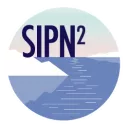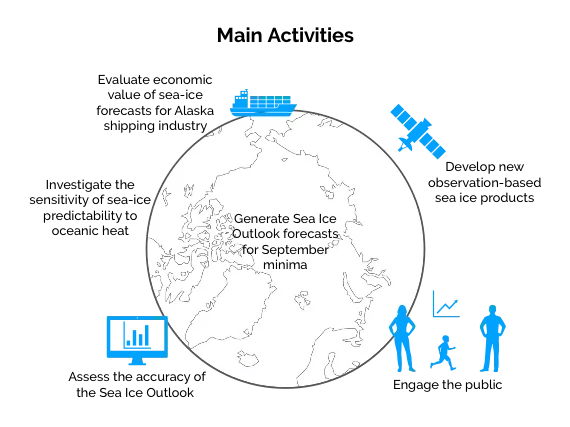
SIPN
Overview
The Sea Ice Prediction Network (SIPN) is a collaborative network of scientists and stakeholders working to improve and communicate sea ice prediction knowledge and tools. We seek to answer:
- What is the predictability of Arctic sea ice at the global, regional and local level using statistical and modeling approaches?
- Can predictions be substantially improved by merging different approaches?
- How can we best observe the state of the ice and ocean to inform sea ice predictability?
- How does a changing Arctic impact predictability?
Why it matters
The amount of sea ice inhabiting the Arctic Ocean varies seasonally. The ice grows throughout the autumn and winter, reaching its annual maximum extent around March, and shrinks in spring and summer, reaching its annual minimum extent around September. Understanding how much sea ice will be present at a given time, especially in the summer months when the Arctic most bustles with activity, is invaluable to a variety of stakeholders. For example, understanding how Arctic sea ice will behave seasonally can assist Arctic communities in planning when they can safely hunt, fish, and travel, allow fishermen and fisheries managers to know when Arctic waters will be open for fishing, and help the shipping industry to predict when the Northern Sea Route will be open for travel.
Researchers have made great strides in accurately predicting this during certain timeframes. However, there are still limitations to predicting the amount of Arctic sea ice one to three months in advance, due to the variability of ocean behavior and weather. This is where the Sea Ice Prediction Network (SIPN) comes in. The SIPN network began in 2014, building off the Sea Ice Outlook (SIO) initiative, which began in 2008, and is coordinated by the Arctic Research Consortium of the United States (ARCUS). It is predominantly funded by the National Science Foundation Arctic Sciences Section and the U.K. Natural Environment Research Council, with other support from NOAA and the U.S. Department of Energy.
SIPN at NSIDC
NSIDC is involved with SIPN in the following ways.
- Leadership & Forecasting: Mark Serreze, Julienne Stroeve, and Walt Meier, all of whom are Arctic sea ice scientists at NSIDC, sit on the SIPN leadership team. NSIDC scientists also contribute predictions to the SIO and use methods they developed to predict September sea ice.
- Coordination & Analyses: NSIDC staff collects sea ice predictions for the SIO and NSIDC scientists contribute to SIO reports in June, July, and August of each year, which contain submitted predictions and discussions on relevant topics.
- Related Data Sets: NSIDC and SIPN have collected a list of data sets that can be helpful for initializing and evaluating hindcast results from predictive models and algorithms, and to support development of a common reference framework for key sea ice variables and integrated datasets.
- Snapshot of the Arctic: This webpage includes links to data visualizations that show current conditions in Arctic sea ice and Arctic temperatures.
Looking to participate in SIPN or explore the SIO archive? Visit the main Arctic Research Consortium of the United States SIPN website.
Related Resources
Arctic Research Consortium of the United States
World Meteorological Organization - The Polar Prediction Project
